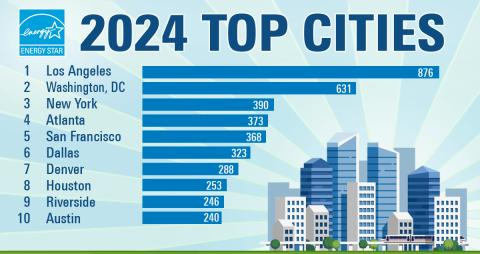Posted by Apolline Andrieu-Delille — May 31, 2024 — The U.S. Environmental Protection Agency (EPA) has announced its annual “Top Cities” list, spotlighting the cities with the greatest number of ENERGY STAR certified commercial and multifamily buildings last year. Los Angeles leads the pack, with 876 Energy Star certified buildings. In second place is Washington, DC, with 631 buildings, followed by New York in third place (390 buildings). Atlanta and San Francisco round out the top five.
According to EPA, the energy used by commercial buildings is responsible for 16% of the nation’s greenhouse gas emissions and costs more than $190 billion per year. Energy Star certified buildings use an average of 35% less energy and are responsible for 35% less carbon dioxide emissions than typical buildings.
EPA Administrator Michael S. Regan remarked:
Cities and communities play an essential role in fighting the climate crisis and reducing energy use in commercial and multifamily buildings. With help from Energy Star, city leaders and building owners are working together to strengthen their economies and businesses, reduce energy bills, and create a healthier environment.
First released in 2009, the EPA’s annual list of cities with the most Energy Star certified buildings shows how buildings across America are embracing energy efficiency as a simple and effective way to save money and reduce greenhouse gas emissions. To create the annual list, the EPA tallies the number of Energy Star certified buildings within each metropolitan area, as defined by the U.S. Census, and creates separate rankings for mid-sized and small cities. These areas include the city itself as well as surrounding suburbs. This year’s list includes buildings that earned the EPA’s Energy Star during the year 2023.
This year’s Top Cities are:
| Rank | Metro Area | Building Count | Last Year’s Rank |
| 1 | Los Angeles, Calif. | 876 | 1 |
| 2 | Washington, D.C. | 631 | 2 |
| 3 | New York, N.Y. | 390 | 5 |
| 4 | Atlanta, Ga. | 373 | 3 |
| 5 | San Francisco, Calif. | 368 | 4 |
| 6 | Dallas, Texas | 323 | 8 |
| 7 | Denver, Colo. | 288 | 6 |
| 8 | Houston, Texas | 253 | 11 |
| 9 | Riverside, Calif. | 246 | 6 |
| 10 | Austin, Texas | 240 | 15 |
| 11 | Chicago, Ill. | 239 | 8 |
| 12 | Boston, Mass. | 213 | 10 |
| 13 | San Diego, Calif. | 209 | 14 |
| 14 | Seattle, Wash. | 187 | 13 |
| 15 | Tampa, Fla. | 167 | 12 |
| 16 | Minneapolis, Minn. | 162 | 16 |
| 17 | Phoenix, Ariz. | 156 | 17 |
| 18 | San Jose, Calif. | 140 | 18 |
| 19 | Sacramento, Calif. | 126 | 21 |
| 20 | Provo, Utah | 125 | n/a |
| 20 | Charlotte, N.C. | 108 | 19 |
| 22 | Miami, Fla. | 102 | 20 |
| 23 | Philadelphia, Pa. | 98 | 22 |
| 24 | Detroit, Mich. | 89 | n/a |
| 25 | Orlando, Fla. | 82 | 23 |
| 25 | Raleigh, N.C. | 82 | 25 |
| Top 10 Mid-Sized Cities | |||
| Rank | Metro Area | Building Count | Last Year’s Rank |
| 1 | Provo, Utah | 125 | 3 |
| 2 | Raleigh, N.C. | 82 | 1 |
| 3 | Louisville, Ky. | 55 | 5 |
| 4 | Jacksonville, Fla. | 53 | n/a |
| 5 | Tulsa, Okla. | 50 | n/a |
| 6 | Grand Rapids, Mich. | 40 | 4 |
| 7 | Des Moines, Iowa | 38 | 2 |
| 8 | Fort Collins, Colo. | 36 | n/a |
| 9 | Albany, N.Y. | 34 | n/a |
| 10 | Salt Lake City, Utah | 33 | 5 |
| Top 10 Small Cities | |||
| Rank | Metro Area | Building Count | Last Year’s Rank |
| 1 | Jackson, Mich. | 34 | 1 |
| 2 | San Angelo, Texas | 22 | n/a |
| 3 | Bloomington, Ill. | 15 | n/a |
| 4 | Sebring, Fla. | 13 | n/a |
| 4 | Manhattan, Kan. | 13 | n/a |
| 6 | Bay City, Mich. | 12 | n/a |
| 6 | Dubuque, Iowa | 12 | 4 |
| 6 | Wheeling, W.Va. | 12 | n/a |
| 9 | Manitowoc, Wis. | 11 | n/a |
| 9 | Carson City, Nev. | 11 | 5 |
| 9 | Russellville, Ark. | 11 | n/a |
Across the country, more than 8,800 commercial buildings earned the Energy Star last year.
As of the end of 2023, more than 43,000 buildings across America had earned EPA’s Energy Star certification. Together, these buildings have saved nearly $6 billion on energy bills and prevented more than 23 million metric tons of greenhouse gas emissions — equal to the annual emissions of more than 3 million homes.
To earn the EPA’s ENERGY STAR, a commercial building must earn an Energy Star score of 75 or higher on the EPA’s 1 – 100 scale, indicating that it is more energy efficient than 75% of similar buildings nationwide. A building’s Energy Star score is calculated based on several factors, including energy use, hours of operation, and a variety of other operating characteristics.
Learn more on ENERGY STAR Top Cities, including this year’s rankings of top small and mid-sized cities, as well as last year’s rankings.
Search for ENERGY STAR certified buildings.
Learn more about earning the ENERGY STAR certification for commercial buildings.





